
The thoughts expressed here are not those of the Republic of Dan but they have stimulated further thinking within the Republic. The truth is often only discernible by the hole it left when it was taken away. Best of luck to you my friend on your journey.
Tuesday, 26 February 2013
Thursday, 21 February 2013
Goebbels favourite slogans. Sound familiar?
Slogans attributed to Goebbels:
Goebbels used to say that "Domination of the street [media] is the first step to state power." "Propaganda means repetition and more repetition!"
"Repeat it until even the densest has got it."
"Denials must always be categoric."
"Denials alone won't work. You've got to counterattack."
"If you repeat a lie often enough, it becomes the truth."
"It would not be impossible to prove with sufficient repetition and a psychological understanding of the people concerned that a square is in fact a circle. They are mere words, and words can be molded until they clothe ideas and disguise."
"The bigger the lie, the more people will believe it."
"The most brilliant propagandist technique will yield no success unless one fundamental principle is borne in mind constantly -- it must confine itself to a few points and repeat them over and over."
"If you tell a lie big enough and keep repeating it, people will eventually come to believe it. The lie can be maintained only for such time as the State can shield the people from the political, economic and/or military consequences of the lie. It thus becomes vitally important for the State to use all of its powers to repress dissent, for the truth is the mortal enemy of the lie, and thus by extension, the truth is the greatest enemy of the State."
-- Joseph Goebbels, German Minister of Propaganda, 1933-1945
Wednesday, 20 February 2013
somalian pirates. Thier other side of the story.
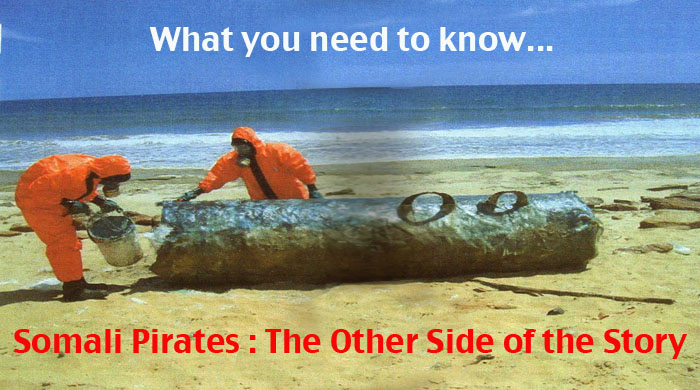
How do I tell you about this?
Most of you have already heard about the Somali pirates. Just recently they captured an American cargo ship and held the captain hostage. They have done this to many other vessels from a variety of different countries. In fact, the American captain was lucky -- he escaped, with the help of some sharp-shooter Navy Seals -- but hundreds of international sailors and crew are still being held by Somali pirates who seek millions of dollars for their safe return, and the safe return of their ships.
You know all this already, though. And you probably think it's just one more evil group of people trying to get rich quick. You probably even think we should just kill them all or find their Somali-based camp and wipe it out and be done with it.
But there's another side of this story you haven't been told. And when you hear it, you might just change your opinion of what's been going on.
I want to first describe Somalia. It's not a beautiful place, in fact it has been compared to hell on earth. All of Africa is poor by western standards, but Somalia is poor by African standards. Decades of drought, famine, genocide, war and corruption have left the inhabitants of this dusty ruin of a country in a constant battle for daily survival.
 The
land is littered with trash and debris from brief periods of hope and
prosperity that cycled through corruption and violence. People live in
huts made of trash and a majority of the nation survives on their only
resource -- the ocean.
The
land is littered with trash and debris from brief periods of hope and
prosperity that cycled through corruption and violence. People live in
huts made of trash and a majority of the nation survives on their only
resource -- the ocean.In the latter part of the 1990s, Somali people began to get sick. It was isolated at first -- skin rashes, some hair falling out, bleeding of the gums, diarrhea... and it came and went. Some people thought it could have been the fish or the water, but no one really could focus on the cause. Then, on Christmas day of 2004, it all became clear.
The great earthquake in Indonesia caused a deadly tsunami that moved west, killing hundreds of thousands of people along the way, and finished by pushing the ocean waters up the Somali coast. After it receded, Somali people found dozens of huge, strange metal cylinders on their shoreline.
Being impoverished but resourceful, people began to open the cylinders and scavenge through the contents. Maybe there was something of value inside... something they could use or sell for food. Some cylinders contained what appeared to be rocks or dirt, others had what looked like plastic and glass trash. Soon, the beaches were littered with the same debris, likely from cylinders that had broken apart under the water.
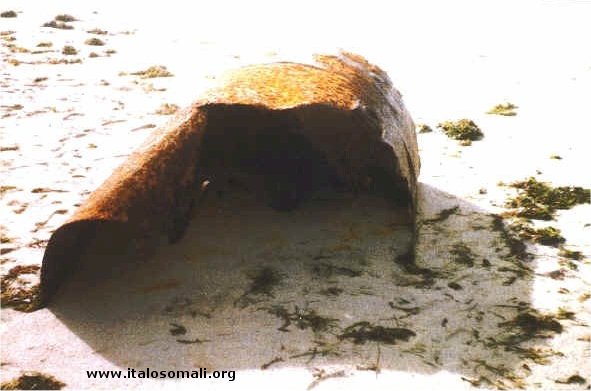
In a schoolyard, the bullies usually pick on the weakest kids. In the global schoolyard, a country without a government to protect its people, like Somalia, is an invitation for abuse. And when the abuse is about money it's a done deal.
The easiest way to abuse Somalia was to rob them of their one great resource -- food. According to Ahmedou Ould-Abdallah, the United Nations envoy to Somalia,
"European ships have been looting Somaia's seas of their greatest resource: seafood. We have destroyed out own fish stocks by over-exploitation ñ and now we have moved on to theirs. More than $300 million worth of tuna, shrimp, lobster and other sea life is being stolen every year by vast trawlers illegally sailing into SomaliaÃs unprotected seas."
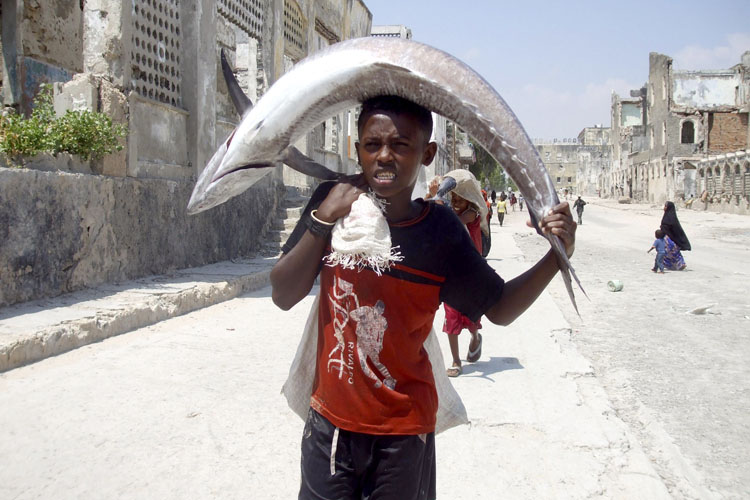
But that's not the worst of it.
In the latter part of the 20th Century, a growing expense to both private corporations and governments has been the disposal of waste -- biological from hospitals and labs, toxic waste from factories and industry and nuclear waste from medical and military use. Even the least expensive disposal of these toxic materials can cost $250 per ton.
But what if a company offered to dispose of these toxic wastes for just $2.50 per ton? You can see where this story is going.
In the mid-90s, a Swiss firm, Achair Partners, and an Italian company, Progresso, offered their quick toxic waste disposal services to a host of European nations. The waste was loaded on to their ships and sailed away. Oh yes, there was talk and plans were made for giant incinerators to neutralize the poisons. It was all supposed to be ecological. But none of the contractors -- mostly European nations -- bothered much to check that out. Yes, the waste was loaded on to their ships and sailed away... only to be dumped in the shallow ocean off Somalia.
After the 2005 tsunami, much of the once submerged waste found it way to the beaches where the broken containers spread debris and toxic particles inland. Nick Nuttall, a UN Environment Program spokesman, said that there are reports from villagers of a wide range of medical problems like mouth bleeds, abdominal hemorrhages, unusual skin disorders and breathing difficulties in many of the northern Somali villages like Hobbio and Benadir.
What? You never heard of this before?
Humans are an amazing species. We are capable of the best and worst. At best we can survive and struggle against almost anything to ensure our survival. The Somali people did. Faced with no government to protect them from the pollution of their ocean, and the depletion of their only source of food, they organized against the dumping. They organized locally in tribes, and the tribes organized clans. With no coast guard, the Somali fishermen tried to thwart off the huge ships that were dumping uranium, mercury, lead, medical waste and other toxins on their food supply and livelihood. They knew their small effort would have little effect on the huge dumping companies... but maybe if the world knew... maybe the world would stop them.
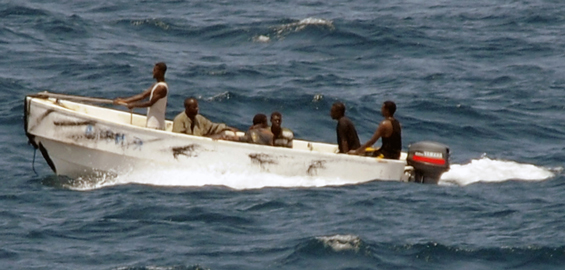
"We are reacting to the toxic waste that has been continually dumped on the shores of our country for nearly 20 years. The Somali coastline has been destroyed. We believe this money is nothing compared to the devastation that we have seen on the seas."
Ex-Somali Army Colonel Mohammed Nureh Abdulle lives in Haradhere ñ the
town in the center of the pirate community. In a BBC interview he said,
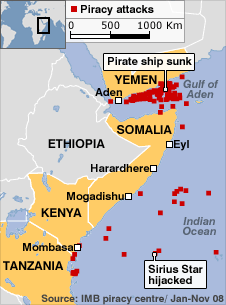 "The town's residents are more concerned with the dumping of toxic waste than piracy... this dumping has been going on for a very long time. In 1991 the government collapsed in this African Nation and certain large corporations took advantage of this. European ships started appearing off the coast of Somalia, dumping thousands of barrels of toxic waste into the ocean. The coastal population began to get sick. At first they suffered strange rashes, nausea and malformed babies and many other symptoms but lacking proper medical attention much was overlooked. Then after the 2005 tsunami, hundreds of the dumped and leaking barrels washed on shore. People began to suffer from radiation sickness and more than 300 died. A few nights ago, some tanks came out from the high sea and they cracked it seems and now they are leaking into the water and into the air. |
 In
August of 2008, a group of about 40 Somalis attacked and seized an
Iranian cargo ship, the Dyanat and took it to the port of Eyl. There it
was secured by a larger group of about 100 Somalis. Within days of
securing the ship, those Somalis that had been on board and inspected
the cargo began to develop strange health problems. They had strange
skin burns, loss of hair, nausea... and a number of men died. The actual
cargo containers were securely locked and the crew claimed they did not
have the access codes to open them. At first the captain said the
containers contained "crude oil" but later admitted they were carrying
"minerals." After a week the ransom was paid and the ship continued.
Many believe it contained radioactive waste that would have been dumped
had the SomaliÃs not intervened.
In
August of 2008, a group of about 40 Somalis attacked and seized an
Iranian cargo ship, the Dyanat and took it to the port of Eyl. There it
was secured by a larger group of about 100 Somalis. Within days of
securing the ship, those Somalis that had been on board and inspected
the cargo began to develop strange health problems. They had strange
skin burns, loss of hair, nausea... and a number of men died. The actual
cargo containers were securely locked and the crew claimed they did not
have the access codes to open them. At first the captain said the
containers contained "crude oil" but later admitted they were carrying
"minerals." After a week the ransom was paid and the ship continued.
Many believe it contained radioactive waste that would have been dumped
had the SomaliÃs not intervened.But humans are also capable of the worst. Despite the Italian Greenpeace announcement in 1992 that this activity was going on, despite the United Nations warning in that same year, despite the Italian parliament's recognition of these activities in 2000, the thousands of Somali people who are sick, the mutations and hundreds of deaths and contaminated fish, even today, these facts are suppressed.
The European nations who signed contracts with Achair and Progresso could care less about a poor country with dark skinned people. In the color spectrum of greed, green trumps every color. It is much easier to ferment hatred for brown or black skinned "pirates" than to admit the real reason for these desperate acts. It is much easier to just "kill them all" than to step in to their shoes (or lack of shoes) and see what options you might choose.

Oh, there's much more I could write about this. I could tell you the guilty individuals who allowed this to happen or how the Somali warlords received arms in return for their complicity. Or the brave journalists like Ilaria Alpi and Mivan Brovato, who were assassinated in Somalia following their interview with a high level whistle-blower... But, for now, open your eyes and look for the truth behind the headlines and sound-bites.
It's much more interesting to think in black and white, good and bad. But too often the truth comes in only one color, the green of money.
Tuesday, 19 February 2013
Human intelligence is declining according to Stanford geneticist

AFP Photo / Johannes Eisele
Dr. Gerald Crabtree, a geneticist at Stanford, has published a study that he conducted to try and identify the progression of modern man’s intelligence. As it turns out, however, Dr. Crabtree’s research led him to believe that the collective mind of mankind has been on more or a less a downhill trajectory for quite some time.
According to his research, published in two parts starting with last year’s ‘Our fragile intellect. Part I,’ Dr. Crabtree thinks unavoidable changes in the genetic make-up coupled with modern technological advances has left humans, well, kind of stupid. He has recently published his follow-up analysis, and in it explains that of the roughly 5,000 genes he considered the basis for human intelligence, a number of mutations over the years has forced modern man to be only a portion as bright as his ancestors.
“New developments in genetics, anthropology and neurobiology predict that a very large number of genes underlie our intellectual and emotional abilities, making these abilities genetically surprisingly fragile,” he writes in part one of his research. “Analysis of human mutation rates and the number of genes required for human intellectual and emotional fitness indicates that we are almost certainly losing these abilities,” he adds in his latest report.
From there, the doctor goes on to explain that general mutations over the last few thousand years have left mankind increasingly unable to cope with certain situations that perhaps our ancestors would be more adapted to.
“I would wager that if an average citizen from Athens of 1000 BC were to appear suddenly among us, he or she would be among the brightest and most intellectually alive of our colleagues and companions, with a good memory, a broad range of ideas, and a clear-sighted view of important issues. Furthermore, I would guess that he or she would be among the most emotionally stable of our friends and colleagues. I would also make this wager for the ancient inhabitants of Africa, Asia, India or the Americas, of perhaps 2000–6000 years ago. The basis for my wager comes from new developments in genetics, anthropology, and neurobiology that make a clear prediction that our intellectual and emotional abilities are genetically surprisingly fragile.”
According to the doctor, humans were at their most intelligent when “every individual was exposed to nature’s raw selective mechanisms on a daily basis.” Under those conditions, adaption, he argued, was much more of a matter than fight or flight. Rather, says the scientists, it was a sink or swim situation for generations upon generations.
"We, as a species, are surprisingly intellectually fragile and perhaps reached a peak 2,000 to 6,000 years ago," he writes. "If selection is only slightly relaxed, one would still conclude that nearly all of us are compromised compared to our ancient ancestors of 3,000 to 6,000 years ago.”
That doesn’t mean it’s all downhill, though. Dr. Crabtree says, “although our genomes are fragile, our society is robust almost entirely by virtue of education, which allow strengths to be rapidly distributed to all members."
"We have a long time to solve it. People 300 years ago had no idea where we'd be scientifically now," he says. "We'll be able to deal with this problem with a range of humane and ethical solutions."
source
Noahs Ark discovered. Again.
by Dan Eden for viewzone
source
Why is this not a BIG story?
I'm often amazed at our lack of knowledge about history. Ordinary people are hungry for this information, yet the organizations responsible to disseminate these facts seem to have an agenda to keep us in the dark. This is especially true when it comes to our ancient human history.
I won't hold you in suspense with this article: The Ark of Noah has been found. It's real. I'll describe the evidence in some detail and end with the historical and religious implications.
How it was discovered
 In
1959, Turkish army captain Llhan Durupinar discovered an unusual shape
while examining aerial photographs of his country. The smooth shape,
larger than a football field, stood out from the rough and rocky terrain
at an altitude of 6,300 feet near the Turkish border with Iran.
In
1959, Turkish army captain Llhan Durupinar discovered an unusual shape
while examining aerial photographs of his country. The smooth shape,
larger than a football field, stood out from the rough and rocky terrain
at an altitude of 6,300 feet near the Turkish border with Iran.
Capt. Durupinar was familiar with the biblical accounts of the Ark and its association with Mount Ararat in Turkey, but he was reluctant to jump to any conclusions. The region was very remote, yet it was inhabited with small villages. No previous reports of an object this odd had been made before. So he forwarded the photographic negative to a famous aerial photography expert named Dr. Brandenburger, at Ohio State University.
Brandenburger was responsible for discovering the Cuban missile bases during the Kennedy era from reconnaissance photos, and after carefully studying the photo, he concluded: "I have no doubt at all, that this object is a ship. In my entire career, I have never seen an object like this on a stereo photo."
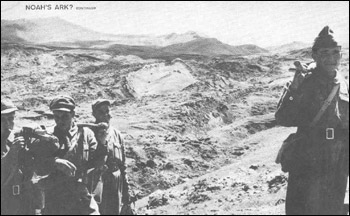
Most of the global media turned away from the find and it became a non-story.
In 1977 Ron Wyatt visited the site. Obtaining official permission, Ron and others conducted more thorough research over a period of several years. They used metal detection surveys, subsurface radar scans, and chemical analysis -- real science -- and their findings were startling. The evidence was undeniable. This was the Ark of Noah.
#1 -- the Visual Evidence
The first part of the survey was to examine the object and take its measurements. The shape looked like hull of a ship. One end was pointed as you would expect from bow [below: D] and the opposite end was blunt like a stern. The distance from bow to stern was 515 feet, or exactly 300 Egyptian cubits. The average width was 50 cubits. These were the exact measurements mentioned in the Bible.
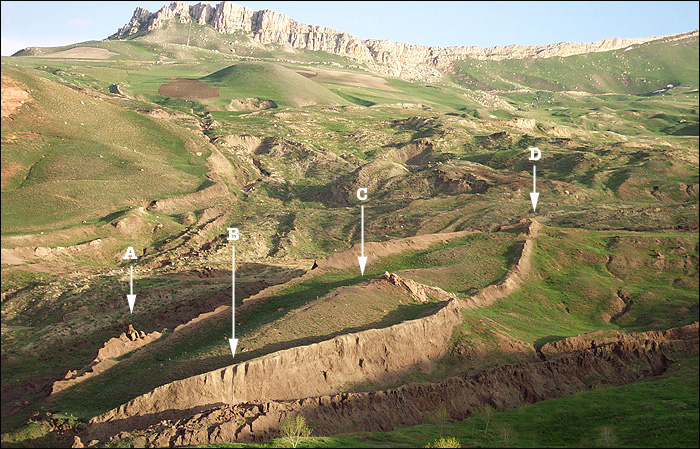
Remember that this object, if it is the Ark, is extremely old. The wood has been petrified. Organic matter has been replaced by minerals from the earth. Only the shapes and traces of the original wood remain. Perhaps this is why the expedition in 1960 was disappointed. They anticipated finding and retrieving chucks of wood, long since eroded.
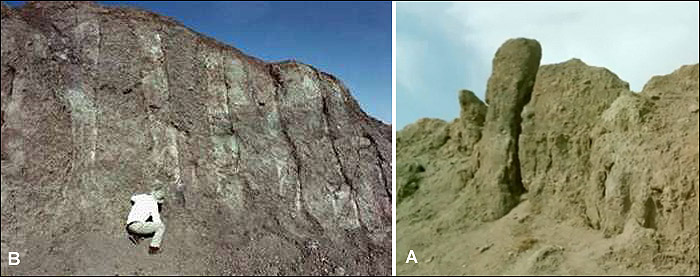
 Biblical
accounts of the Ark describe it as having as many as six levels. The
assumed shape of the Ark seems consistent with the bulge [C] in
the middle of the object. In fact, as we will soon learn, radar scans of
the structure suggest that this bulge is the collapsed debris of these
levels.
Biblical
accounts of the Ark describe it as having as many as six levels. The
assumed shape of the Ark seems consistent with the bulge [C] in
the middle of the object. In fact, as we will soon learn, radar scans of
the structure suggest that this bulge is the collapsed debris of these
levels.Although most people think of the Ark as being rectangular, that only applies to the top decks. The sleek shape of the hull is necessary to enable the huge ship to remain stable in the water and survive tremendous waves.
#2 -- Ground Penetrating Radar
The human eye needs to see reflected light to recognize an object. To visualize what remains below the earth, scientists use microwaves which can penetrate the ground and bounce back when they hit something solid. This technique is commonly used to locate oil and other minerals. Called Ground Penetrating Radar (GPR), the apparatus us made from an antenna that transmits, then listens to receive the "echo" and prints the result on a piece of paper. The delay and strength of this echo tell the geologists how solid and at what depth the objects are under the earth.

"This data does not represent natural geology. These are man made structures. These reflections are appearing too periodic... too periodic to be random in that type of natural pace." -- Ron Wyatt of SIR Imaging team
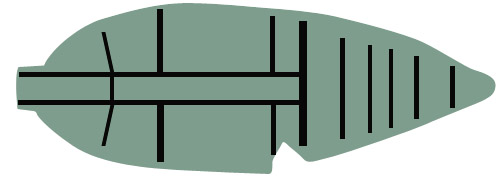
#3 -- Artifacts retrieved from the Ark
Using the GPR, Ron Wyatt discovered an open cavity on the starboard side. He used an improvised drill to make core sample inside this cavity and retrieved several very interesting objects. Below you can see the artifacts which were sent for laboratory analysis. On the left is the bore hole [see below], followed by what turned out to be petrified animal dung, then a petrified antler and lastly a piece of cat hair.

Perhaps the most significant find from the Ark itself is a piece of petrified wood. When this was first found it appeared to be a large beam. But upon closer examination it is actually three pieces of plank that have been laminated together with some kind of organic glue! This is the same technology used in modern plywood. Lamination makes the total strength of the wood much greater than the combined strength of the pieces. This suggests a knowledge of construction far beyond anything we knew existed in the ancient world.

Examination reveals the glue oozed from the layers. The outside of the wood appears to have been coated with bitumen.
Even more surprising were laboratory analyses which not only revealed that the petrified wood contained carbon (proving it was once wood) but there were iron nails [above right] embedded in the wood!
In Genesis 6:14, God told Noah to "make yourself an ark of gopher wood."
 "Gopher
wood" is a misreading and scribal error. "Kopher" wood is correct and
means wood (any wood) that is covered with Kopher. Kopher is bitumen.
In the Genesis text (6:14), the context is clear. The GPR wood used, (a
scribal error) is to be covered in KPR. G and K in Hebrew are so
similar that inexperienced Hebrew "scholars," such as those translating
the King James Version of the Bible, could have been prone to such
errors, indeed, they made many such errors. "Gopher
wood" is a misreading and scribal error. "Kopher" wood is correct and
means wood (any wood) that is covered with Kopher. Kopher is bitumen.
In the Genesis text (6:14), the context is clear. The GPR wood used, (a
scribal error) is to be covered in KPR. G and K in Hebrew are so
similar that inexperienced Hebrew "scholars," such as those translating
the King James Version of the Bible, could have been prone to such
errors, indeed, they made many such errors.Acts 7: 45 & Hebrews 4: 8 are classic examples of such scribal errors. gpr = "g," as in gopher, k pr = "k,"as in kopher Pictured right is a simple visual comparison of the letters. |
The most surprising find was discovered with sensitive metal detectors. The team located several strong "hits" that, when dug up, revealed large disc shaped rivets. From simple observation of the metal it was possible to see where the rivet had been hammered after being inserted through a hole [below].
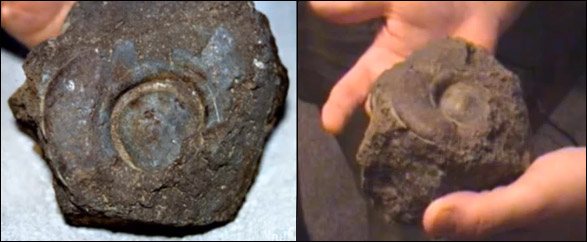
An analysis of the metal used to make the rivets revealed that they were a combination of iron (8.38%), aluminum (8.35%) and titanium (1.59%). Remember these trace metals have survived petrification and so do not indicate the exact content in the original material. (see Report from Galbraith Labs)
We know the aluminum was incorporated in the metallic mixture because it does not exist in metallic form in nature. This implies an extremely advanced knowledge of metallurgy and engineering. Characteristics of an iron-aluminum alloy have been investigated in The Russian Chemical Bulletin (2005) and reveal that this alloy forms a thin film of aluminum oxide which protects the material from rust and corrosion. The addition of titanium would provide added strength. This seems to have worked. The rivets have survived from antiquity!
The surrounding area has more surprises
Several miles from the location of the Ark, huge stones were discovered, some standing upright while others lying on the ground. These stones, weighing many tons, have holes carved in them. Scientists have determined that they were anchors and the holes would have been their attachment to a ship with hemp rope.
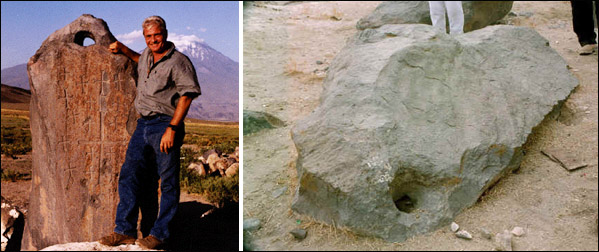
"And the Ark rested in the seventh month, on the seventeenth day of the month, upon the mountains of Ararat. And the waters decreased continually until the tenth month: in the tenth month, on the first day of the month, were the tops of the mountains seen." -- Genesis 8:4-5The Gilgamesh Epic (650 BC) gives Mt. Nisir as the landing place of the Ark. The local name for the town where the Ark was found is Nasar.
The annals of Ashurnasurpal II of Assyria (833-859 BC) places it south of the Zab river (correct).
Theophilus of Antioch (115-185 AD) said the Ark could be seen in his day in the Arabian mountains. Later Church Fathers also mention the Ark as late as the mid 7th century.
In the 13th century, Willam, a traveler, stated for the first time that Mt. Masis was the Ark location (present-day Mt. Ararat).
Ptolemy's Geographia (1548) mentions the mountains of Armenia as the place of landing. So does the traveler Nicolas de Nicolay (1558).
Pilgrims to the site would gather bits and pieces of the petrified wood which would be used as charms to ward off evil. When they encountered the anchors, they had no doubt about their association with the Ark. They often carves one big cross to represent Noah and smaller crosses representing his family.
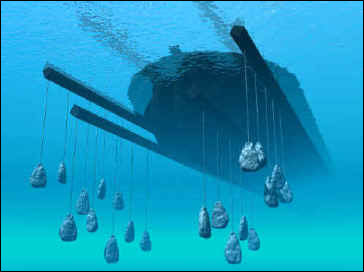
After Noah's Ark landed
When Dr. Brandenburger originally examined and enlarged the photographs of the "strange object" in Turkey, he also saw hundreds of ancient foundations in the region, suggesting to him that this might have been the first town established after the flood, as described in the Bible.
Now their settlement extended from Mesha as you go toward Sephar, the hill country of the east. -- Genesis 10:30
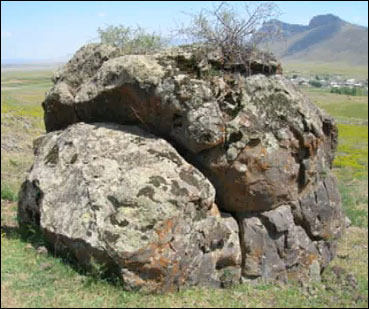
Then Noah built an altar to the Lord, and took of every clean animal and of every clean bird, and offered burnt offerings on the altar. And the Lord smelled a soothing aroma. Then the Lord said in His heart, "I will never again curse the ground for man's sake, although the imagination of man's heart is evil from his youth; nor will I again destroy every living thing as I have done. While the earth remains, Seedtime and harvest, Cold and heat, Winter and summer, And day and night Shall not cease.Again, it surprised me when I research a story like this and find substantial evidence that something extremely important has been found, yet it has been ignored by historians and the media. Perhaps it is because the advanced technology discovered in the Ark suggests that Sumerian legends, the Epic of Gilamesh, and other ancient writing might actually be correct when they speak of an extraterrestrial connection. The plural of god -- Elohim -- is used even in Genesis. Who were these "gods" and how did they walk the Earth and interact with humans of the era...
Or perhaps this discovery should be seen as a good reason to accept the Bible at its word.
We all need to look deeper into our past to learn what sort of beings we really are, where we are coming from and where we are going.
What do you think of this?
Pope Benedict to seek immunity and protection from Italian President Giorgio Napolitano on February 23
Posted on
February 14, 2013 by
itccs
International Tribunal calls on Napolitano to "not collude in criminality", and announces global campaign to occupy Vatican property and launch human rights inquiry in Italy
Rome (9 am local time):Pope Benedict, Joseph Ratzinger, has scheduled a meeting with Italian President Giorgio Napolitano for Saturday, February 23 to discuss securing protection and immunity from prosecution from the Italian government, according to Italian media sources.
Ratzinger's meeting follows upon the apparent receipt by the Vatican of a diplomatic note from an undisclosed European government on February 4, stating its intention to issue an arrest warrant for Ratzinger, who resigned from his pontificate less than a week later.
In response to the February 23 meeting, the International Tribunal into Crimes of Church and State (ITCCS), through its field Secretary, Rev. Kevin Annett, has written to President Napolitano, asking him to refrain from assisting Ratzinger in evading justice.
The ITCCS letter states, in part,
"I need not remind you, Mr. President, that under international law and treaties that have been ratified by Italy, you and your government are forbidden from granting such protection to those like Joseph Ratzinger who have aided and abetted criminal actions, such as ordering Bishops and Cardinals in America and elsewhere to protect known child rapists among their clergy.
"Your obligation to the Vatican through the Lateran Treaty does not negate or nullify the requirements of these higher moral and international laws; nor does it require that you give any protection or immunity to a single individual like Joseph Ratzinger, especially after he has left his papal office."
These actions will accompany the legal efforts to bring Joseph Ratzinger and other Vatican officials to trial for their proven complicity in crimes against humanity and criminal conspiracy.
The Easter Reclamation Campaign will seize church property and assets to prevent their use by child raping priests, who are protected under Catholic canon law. Citizens have this right to defend their communities and children when the authorities refuse to do so, under international law.
Rev. Kevin Annett and an official delegation from the ITCCS Central Office will also be convening a formal human rights inquiry in Rome commencing the week of May 13, 2013, to consider further charges against the Vatican and its new Pope for crimes against humanity and obstruction of justice.
Rev. Annett and his delegation will be working with organizations across Italy in this investigation. In 2009 and 2010, he held rallies outside the Vatican and met with media and human rights groups across Italy to charge the Vatican with the death of more than 50,000 aboriginal children in Canada.
source
further reading
Monday, 18 February 2013
Space slime
A "weird" green slime said in folklore to appear at the
same time as meteors hit Earth has been found in a birdlife park in
Somerset.
The RSPB has appealed for help in identifying the slime, which is said
to be scattered on grass banks close to pools and lakes around Ham Wall
Nature Reserve near Glastonbury.The jelly-like substance could be bacteria, fungus or toad innards, wildlife experts said.
Some believe it could be a substance that has been written about for centuries called star or astral jelly, which is said to appear in the wake of meteor showers.
Its appearance has coincided with a meteor strike in Russia and the harmless fly-by of an asteroid at a record distance from Earth last week.
Steve Hughes, the RSPB site manager at Ham Wall, said: "This past week we've been finding piles of this translucent jelly dotted around the reserve.
"(It is) always on grass banks away from the water's edge. They are usually about 10cm (4in) in diameter.
"We've asked experts what it might be, but as yet no one is really sure. Whatever it is, it's very weird."
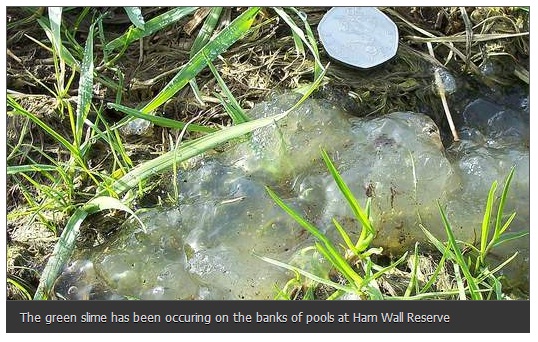

"In records dating back to the 14th Century it's known variously as star jelly, astral jelly or astromyxin.
"In folklore it is said to be deposited in the wake of meteor showers."
One of the more favoured explanations is that it is a form of cyanobacteria called Nostoc.
Others suggest that it is the remains of the regurgitated innards of amphibians such as frogs and toads, and of their spawn.
Alternatively, it may be related to the intriguingly named crystal brain fungus.
Mr Whitehead added: "We've read a few articles now, and much speculation.
"One suggested it was neither animal nor plant, and another that it didn't contain DNA, although it does give the appearance of something 'living'.
"Our reserve team will be looking out for the slime over the next few days, but if anyone can offer any explanations we'd be glad to hear."
The public are being warned not to touch the mystery substance, and to inform nature reserve staff if they spot any.
source
Sunday, 17 February 2013
new "Zombie" cells created by science
'Zombie' Cells May Outperform Live Ones as Catalysts and Conductors
Feb. 7, 2013 — "Zombie"
mammalian cells that may function better after they die have been
created by researchers at Sandia National Laboratories and the
University of New Mexico (UNM).
The simple technique coats a cell with a silica solution to form a near-perfect replica of its structure. The process may simplify a wide variety of commercial fabrication processes from the nano- to macroscale.
The work, reported in the Proceedings of the National Academy of Sciences (PNAS), uses the nanoscopic organelles and other tiny components of mammalian cells as fragile templates on which to deposit silica. The researchers then heat the cell to burn off its protein. The resultant hardened silica structures are faithful to the exterior and interior features of the formerly living cell, can survive greater pressures and temperatures than flesh ever could, and can perform some functions better than when they were alive, said lead researcher Bryan Kaehr, a Sandia materials scientist.
"It's very challenging for researchers to build structures at the nanometer scale," said Kaehr. "We can make particles and wires, but 3-D arbitrary structures haven't been achieved yet. With this technique, we don't need to build those structures -- nature does it for us. We only need to find cells that possess the machinery we want and copy it using our technique. And, using chemistry or surface patterning, we can program a group of cells to form whatever shape seems desirable."
UNM professor and Sandia Fellow Jeff Brinker added, "The process faithfully replicates features from the nanoscale to macroscale in a robust, three-dimensionally stable form that resists shrinkage even upon heating to over 500 degrees Centigrade [932 degrees Fahrenheit]. The refractoriness of these delicate structures is amazing."
The unusual but simple procedure may serve as a model for creating hardier classes of nanoscopic products.
Because a cell is populated by a vast range of proteins, lipids and scaffolding, its interior is ready-made to model catalysts, funnels, absorbents and other useful nanomachinery, said Kaehr, a former Sandia Truman Fellow.
Catalysts that evolve in cells are enzymes that have to retain a certain shape for their chemistry to work. Since structure is important to function, stabilizing a catalyst in the shape it evolved is important, Kaehr said. Heat-hardened silica would stabilize and protect the still-present protein as it did its work.
UNM post-doctoral student Jason Townson said the most immediate use for silicification may be as a simple way to preserve the structure of organic materials for imaging.
"Formerly, for internal preservation and subsequent imaging, a cell would be fixed in formaldehyde or some other preservative. But many of these methods are labor-intensive," Townson said. "This method is simple. The preserved cells will never get sloppy in decay. And when we cracked open the resulting structure, we were blown away by how well the cell was preserved, down to the minor groove of the cell's DNA."
Heating the cell to still higher temperatures (greater than 400 degrees C) evaporates the organic material of the cell -- its protein -- and leaves the silica in a kind of three-dimensional Madame Tussauds wax replica of a formerly living being. The difference is that instead of modeling the face, say, of a famous criminal, the hardened silica-based cells display internal mineralized structures with intricate features ranging from nano- to millimeter-length scales.
The construction process is relatively simple: Take some free-floating mammalian cells, put them in a petri dish and add silicic acid.
Through the action of methanol, a byproduct of the acid, the cell's lipid layers -- the protective casings that keep the cell intact -- are softened and made porous enough for the silica to flow in at about the temperature of the human body.
The silicic acid, for reasons still partially obscure, enters without clogging and in effect embalms every organelle in the cell from the micro- to the nanometer scale.
If the cell isn't heated, the silica forms a kind of permeable armor around the protein of the living cell. This may support it enough to act as a catalyst at temperatures and pressures undreamed of by nature.
"Once we've used silica to stabilize the cellular structure, it can still carry out reactions and, more importantly, that reaction is stable enough to work at high temperatures," Kaehr said. "The method is also a means to take a soft, potentially valuable biological material and convert it to a fossil that will stay on our shelves indefinitely."
Ordinarily, preserving something organic means freezing it, which is energy-intensive, he said. Instead, "We're doing rapid fossilization: quickly converting a protoplasmic cell into a hard structure that will stand the test of time."
Experiments showed the cell can be used as a reverse mold from which, at 900 degrees C, a porous carbonized structure results from heating cell protein in a vacuum. In other words, in the same way that burning wood in air leaves a residue of structureless soot, the zombie heating method results in a high-quality carbon structure. Subsequent dissolution of the underlying silica support decreased the cell's electrical resistance by approximately 20 times. Such materials would have substantial utility in fuel cells, decontamination and sensor technologies.
That such extraordinary results can be achieved by silicifying cells indicates many soft cellular architectures could be "feedstock for most materials processing procedures, including those requiring high temperatures and pressures," according to the technical paper.
Other porous material structures, relying on titanium instead of silica, have been formed using the organic template technique. Other metal oxides, said Kaehr, are a possibility. These would have more complex structural functions or could serve as catalysts.
The work follows the efforts of a number of scientific groups, including Kaehr's, that have built gel-like structures, copied them with silica and then burned off the gel to create, in effect, large sponges.
"Now we can change the biological shape and calcify (heat) it, so for the first time we get new irregular structures," Kaehr said.
Summing up, Kaehr offers what may be the first distinction in scientific literature between a mummy cell and a zombie cell: "King Tut was mummified," he said, "to approximately resemble his living self, but the process took place without mineralization [a process of fossilization]. Our zombie cells bridge chemistry and biology to create forms that not only near-perfectly resemble their past selves but can do future work."
The work was supported by DOE's Office of Science. Co-authors are Brinker, Brian Swartzentruber of Sandia and the Center for Integrated Nanotechnologies, and, from UNM, Robin Kalinich, Darren Dunphy and student Yasmine Awad.
Saturday, 16 February 2013
Lighting strikes Dome of St. Peter's same day Pope Benedict XVI announces resignation
sourceThe image of the day is Alessandro Di Meo, photographer agency Ansa. The photographer was able to capture a lightning strike on the dome of St. Peter on the day the announcement of the resignation of Pope Benedict XVI.
Tuesday, 5 February 2013
Obama only wants military leaders who 'will fire on U.S. citizens'
On Monday, renowned author and humanitarian Dr. Jim Garrow made a shocking claim about what we can expect to see in Obama's second term.
This comes on the heels of Sunday's report in the Washington Free Beacon (WFB) that the head of Central Command, Marine Corps Gen. James Mattis is being dismissed by Obama and will leave his post in March. The WFB article states: “Word on the national security street is that General James Mattis is being given the bum’s rush out of his job as commander of Central Command, and is being told to vacate his office several months earlier than planned.” Did Gen. Mattis refuse to "fire on U.S. citizens?" Related articles: Is martial law imminent?
link
Monday, 4 February 2013
What Is Agenda 21?
source
Those who follow Glenn Beck might be
aware that Tuesday marks the release of his latest book, “Agenda 21,”
the suspenseful and perhaps sobering tale of a futuristic America in
which a UN-led program spawned an authoritarian state where individuals
are stripped of all personal rights and freedoms.
Oddly, Beck’s novel is not simply a
work of fiction, but based on an actual program created by the United
Nations by the very same name — “Agenda 21″ — which, according to the
UN’s own website,
is a “comprehensive plan of action to be taken globally, nationally and
locally by organizations of the United Nations system, governments and
major groups, in every area in which human impacts on the environment.”
In so many words, the United Nations
seeks to co-opt, via individual governments, and eventually, a
“one-world government,” privately held land under the auspices of
ensuring its “sustainability.” Worse still, the UN’s Agenda 21 has even
laid out plans for “depopulation” or rather, “population control.” If it
sounds like something out of George Orwell’s 1984, that is because
Agenda 21′s tenets are eerily in line with the demented alternate
reality Orwell himself had imagined while scribing the pages of his
famed novel.
“Sustainable development” is the catch-phrase Beck urged his Monday evening viewers to be leery of.
Where one can live and what land should
be designated for would, under fully-realized Agenda 21 plan, be
controlled by the United Nations and a future one-world government.
Consider the following section from the UN website on Agenda 21′s plan for “promoting sustainable human settlement development.” Emphasis added:
The overall human settlement objective is to improve the social, economic and environmental quality of human settlements and the living and working environments of all people, in particular the urban and rural poor. Such improvement should be based on technical cooperation activities, partnerships among the public, private and community sectors and participation in the decision-making process by community groups and special interest groups such as women, indigenous people, the elderly and the disabled. These approaches should form the core principles of national settlement strategies. In developing these strategies, countries will need to set priorities among the eight programme areas in this chapter in accordance with their national plans and objectives, taking fully into account their social and cultural capabilities. Furthermore, countries should make appropriate provision to monitor the impact of their strategies on marginalized and disenfranchised groups, with particular reference to the needs of women.7.5. The programme areas included in this chapter are:(a) Providing adequate shelter for all;(b) Improving human settlement management;(c) Promoting sustainable land-use planning and management;(d) Promoting the integrated provision of environmental infrastructure: water, sanitation, drainage and solid-waste management;(e) Promoting sustainable energy and transport systems in human settlements;(f) Promoting human settlement planning and management in disaster-prone areas;(g) Promoting sustainable construction industry activities;(h) Promoting human resource development and capacity-building for human settlement development.
Watch below as Beck explains exactly
what Agenda 21 is and how everyday Americans are already experiencing
its implementation, perhaps without even realizing it. The videos that
follow feature Agenda 21 experts — even one self-proclaimed “liberal
democrat” — delving deeper into this sinister-sounding agenda. They
discuss how the program has slipped under the radar, working its way
into everyday life slowly but surely, and what the outcomes of full
implementation would be.
Australian politican speaks out against agenda 21
Saturday, 2 February 2013
FBI kicked out of Iceland
FBI Came to Investigate Wikileaks in Iceland
A group of FBI agents arrived in Iceland in August 2011,
requesting collaboration with Icelandic police authorities to
investigate Wikileaks, as revealed by Wikileaks spokesperson Kristinn
Hrafnsson on RÚV’s news magazine Kastljós last night.

Kristinn Hrafnsson. Photo: Páll Stefánsson/Iceland Review.
“According to my information, he demanded that these agents pack their bags, embark the plane and leave the country,” Kristinn added. “I know that this was later discussed within the government, which formally objected to U.S. authorities.”
Ögmundur confirmed Kristinn’s statement to RÚV, saying a group of foreign agents came to the country in August 2011, requesting assistance to investigate a certain affair. Their request was rejected as it is unnatural for foreign police forces to carry out investigations in Iceland, the minister reasoned.
Subscribe to:
Comments (Atom)



